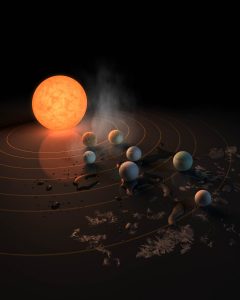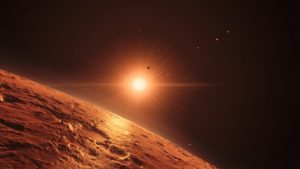[lead] Arjune Nibber | Online Reporter | Saltman Quarterly (2016-2017)[/lead]
Through centuries of experiments, theories, and discoveries made about the wonders of our planet, astronomers from across the world have looked to the stars, wondering, “is it just us? Is it just Earth?”. The fascination of life, or the possibility of life, on other planets and in other galaxies continues to be at the forefront of astronomy. Even now in the 21st century, human fascination with life’s inception and the concept of extraterrestrial travel has permeated through academic study, literature, and on-screen media. The futuristic ideas on what could possibly be out there are undeniably thought-provoking, but often seem out of reach. Life beyond Earth is a bewildering concept, especially when we have a limited understanding of how life even began and was sustained on our own planet. A large part of the extraterrestrial question centers around humans going beyond our solar system, to explore other worlds and galaxies. Intergalactic travel is an amusing topic, but realistically, what does it matter if there’s nothing to travel to? Yet a recent discovery made by NASA has brought the science fiction much closer to the reality. The astonishing discovery of TRAPPIST-1, a star with not just one, but three potentially habitable planets has reignited excitement over the prospect: Is life possible out there?

TRAPPIST-1 is a recently discovered star in the Aquarius constellation. It is an ultra-cooled dwarf star, meaning it’s much smaller in both size and energy output when compared to our Sun. However, one characteristic it shares with the Sun, and with most other stars, is a habitable zone, in which a rocky body is far enough away that liquid water could exist on the surface, but close enough that it can be energized. These are essential components for the existence of life, and luckily, TRAPPIST-1 boasts three planets out of its total seven revolving within this zone. On its own, the discovery of planets outside our solar system is not an astonishing find; several thousand planets have been found, and considering the size of the universe, hundreds of billions of others must exist that aren’t currently observable. It’s the life hosting potential of these planets that makes the revelation so extraordinary. The fact that so many have been found at an observable distance, meaning further explorations and tests can be run on them, is, literally, an astronomical miracle.
So what does this mean for the future of science, and more broadly, the future of life? The probability of life existing somewhere else in the universe besides Earth increases immensely with this discovery. In a universe filled with hundreds of billions of planets, of course some of them have to be hospitable to life, especially now that we’ve seen three of them. With this theory also arises the assumption that, if other planets are able to host life, then it’s possible that they already are. We very likely are NOT alone. The burdens of life, the responsibilities associated with protecting it and making the most out of it, no longer rest solely on planet Earth. The sense of isolation that comes from being the only place in the universe where life exists is no longer something we need to preoccupy ourselves with. Asides from the comforting fact that our unknown neighbors are out there somewhere, the existence of these planets with the same habitable conditions that gave rise to living creatures also implies that one day, we’ll have a more complete picture of our biggest mystery; how did life begin?
In the more immediate sense, this discovery makes huge advancements for the idea of interplanetary colonization. It isn’t as farfetched as it seems, and scientists and government authorities have been thinking about it for a while. NASA has even maintained pages of information on the subject for years before the discovery of TRAPPIST-1, and the company Mars One has proposed a project for the colonization of Mars, with the first manned flight planned optimistically for the year 2031. The fact is, as boundless as the potential of Earth seems, it comes with an expiration date. It isn’t something we’d likely have to worry about in our lifetimes, but for the future of the human race, and life on Earth in general, it’s inevitable that Earth will reach its end, either by red giant formation, asteroid collision, or atmospheric stripping. So if the life that originated here is to survive, it would become necessary for it to move on to somewhere else. In fact, it’s a basic promise of modern science; that advancements in biology, chemistry, physics, and engineering will guarantee an untouchable prosperity of humans and life. One of the ways it expects to fulfill this promise is by simply moving on to another planet, another solar system, another galaxy. Space colonization is not even considered just a possibility by some in the field; it’s simply an eventuality.

Human life on another planet in the universe would advance science in unparalleled ways. Critical analysis of almost every field would be incredible given the context of a new planet. Laws of physics could be further analyzed, chemical properties reanalyzed, and biological systems examined under extremely unique environments. More importantly, we would ensure the continuation of humanity and life as we know it. And as we venture out to other planets and solar systems, exploring things we never thought possible before, finding our niche on a universal scale, our understanding of the universe and ourselves would deepen in astounding ways.
But with all the advancements, personal and scientific, the promise of interplanetary travel provides, comes caveats. Even as we are now limited to the confines of our own planet, we take too many of its miracles for granted. The environment is pillaged, the atmosphere polluted, and species go extinct on a magnitude of days, at a rate never before seen in the history of Earth. The life-sustaining properties scientific chance blessed this planet with are being destroyed by the very creatures this planet conceived. And that is with the understanding that these resources are limited. What would happen if suddenly, whole other planets were to open up to potential human conquest? Yes, the potential for life and habitable planets is a characteristic of this universe, but the existence of such planets, especially those that are observable or accessible, are few and far between. The universe and those planets would be unable to survive a human mentality in which environmental concerns are prioritized even less than they are now. Knowing that another planet is waiting for us is going to justify forgoing conservation efforts. The possibility of that happening is extremely high, especially when considering the current state of environmental concern. Expanding our role in the universe is not something to be done without moderation. Before we even consider the possibility of expanding our reach beyond this planet, we need to accept the responsibility we have on our own planet, especially if we are to take on more.
[hr gap=”0″]
Sources:
- https://www.nasa.gov/press-release/nasa-telescope-reveals-largest-batch-of-earth-size-habitable-zone-planets-around
- https://www.nytimes.com/2017/02/22/science/trappist-1-exoplanets-nasa.html?_r=0
- http://news.nationalgeographic.com/2017/02/seven-planets-not-aliens-nasa-earth-space-science/